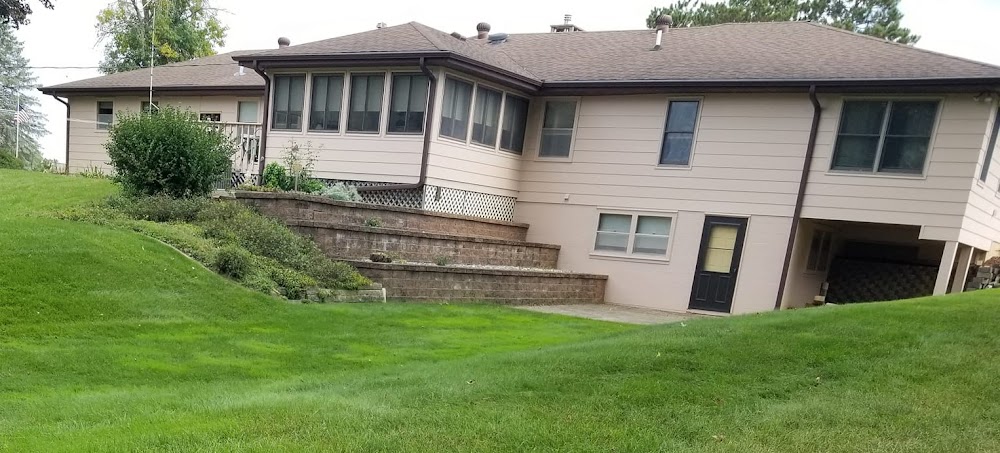Today I share an unknown, to us, woman in a photo from the collection of Jerry's late Aunt Marie. There were no names nor year noted and no one seems to know who she is/was.
It was a professional studio photo taken by "Berniece of The New Shoemaker Studio in Beardstown" so noted on the cardboard folder.
She is attractive posed in somewhat formal attire, long skirt with one foot upon the bottom of the post, her necklace looks as though it might be carved from some stone, onyx or? What was the occasion for the photo? The sleeves of her blouse echo the folded fabric on the posts. My guess is this might have been in the 1940's. What was happeing then in Beardstown?
Beardstown, located on the Illinois River was founded by Thomas Beard, from Granville, New York, when he started a ferry service crossing the river in 1826. By 1834 it was a growing port that shipped grain, hogs, and provisions to the interior of the state and downriver to markets. Beardstown became known as "Porkopolis" because of its stockyards and slaughterhouses, where more than 50,000 hogs were processed annually. Beard's license authorized him to charge $.75 for a wagon and four horses (or oxen), $.37 1/2 for a cart and horse, $.05 per head of cattle, and $.06 1/4 for a pedestrian, among other tolls. The ferry ran until 1888, when a private wooden toll bridge was built. In 1898 the city built a steel toll bridge that afforded the town revenue until 1955, when the state built a bridge a mile south. In the mid-nineteenth century steamboats were built at Beardstown. A plank road was built between Beardstown and Bluff Springs to the east, to cover a swampy area that impeded wagon trade over the otherwise clay surface of the area.
The railroad came to Beardstown in 1869 with the laying of the Rockford, Rock Island, and St. Louis Railroad track. Beardstown was an important division point where engines and crews changed on the Galesburg to East St. Louis run and where the branch, or "jack," line to Centralia merged.
At the turn of the century, the Beardstown Fish Company frequently reported catches of between 50,000 and 100,000 pounds of fish. Black bass, carp, buffalo, crappie, eel, catfish, frogs, and turtles were caught, sold, and shipped from Beardstown. Fishing declined as the river became polluted and levees were built, draining lakes.
Another short-lived industry was mussel and freshwater pearl fishing. Button factories opened along the Illinois and Mississippi Rivers in the 1890s. Hundreds in the Beardstown area were given employment shelling mussels and selling their shells and pearls to commercial buyers. Prices as high as $1,500 for a large pearl were not unusual. Irregularly shaped pearls, called "slugs," sold for as much as a hundred dollars. By 1909 local shell beds had been played out. They were rejuvenated by the 1970s, when prices per ton were high enough for a few shellers to work the beds again. The shells are sold to Japan, to be ground up into "seeds" for oyster pearls. I have heard of this industry near here along the Mississippi River in Iowa.
A third industry, ice cutting, was prosperous until 1909, when the first plant making artificial ice was installed. Ice was packed in sawdust and stored in large icehouses to be sold locally in the summer months, and it was also shipped out by the train-carload.
Today it is the site of two grain terminals where farm products are transferred to barges for transport. A large Cargill meat processing plant is a major employer and has attracted a substantial immigrant population to Beardstown in recent years. By the 2010 US census it had a population of slightly over 6000.
So who was she and what was she doing in Beardstown, all dressed for a gala?
For others posts on this long holiday weekend here in the states, go to the Sepia site at this link
http://sepiasaturday.blogspot.com/2012/11/sepia-saturday-153-24-november-2012.html



Great mystery and interesting information about Beardstown. Somehow the elegant lady doesn't seem to fit the place. She seems like she would be much more comfortable in Chicago. Her blouse is stunningly elegant - fashion designers take note!
ReplyDeleteI agree Liz, I thought the place might be nearer Chicago too.
DeletePat it's nice to see you back on Sepia Saturday and with such a stunningly beautiful lady too. We both have mystery women in our posts this week! By the way, unless I missed it, I couldn't see you on Mr Linky. I found you through the comments.
ReplyDeleteI will go check that I did sign in but maybe did not do something correctly
DeleteElegant lady, whoever she was. :)
ReplyDeleteWhoever she is, she is lovely! Isn't it amazing how a single unidentified photo can lead to so much research? Great post, Pat :-) Jo
ReplyDeleteEnjoyed reading about Beardstown, even if your research did not solve the mystery of the lady in the photo. Like yourself, I often get carried away and find myself researching something online usually because of some place we've travelled to; other times just plain curiosity. Back in the day, many folks went to professional photographers for photos, many of which you can now find in antique stores and are always fun to rummage through. I once joked about buying some of those unknowns and displaying them as "family" photos in our home.
ReplyDeleteLovely lady. These unknown old photographs often lead to mysterious adventures.
ReplyDelete